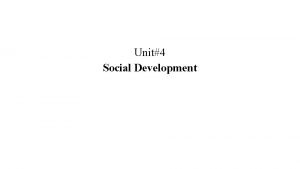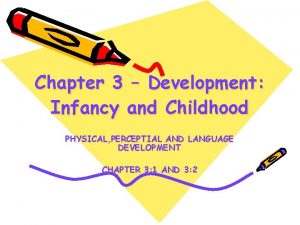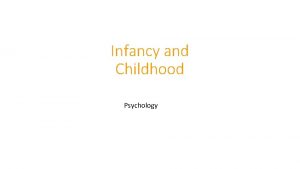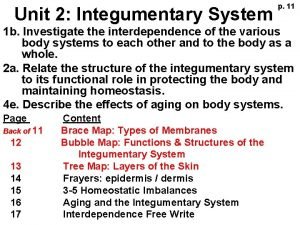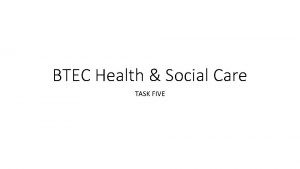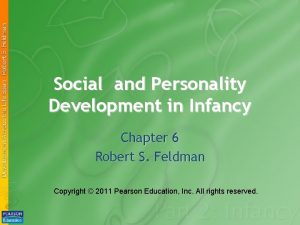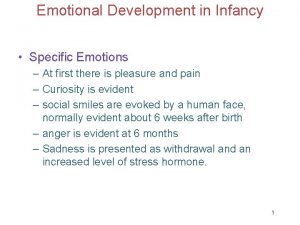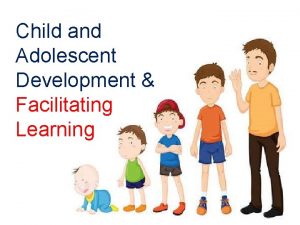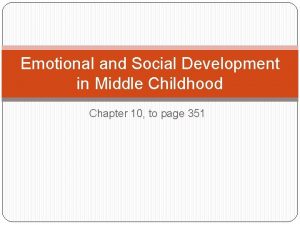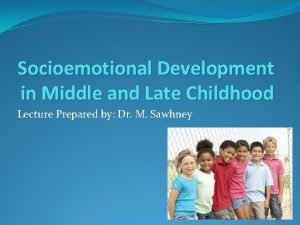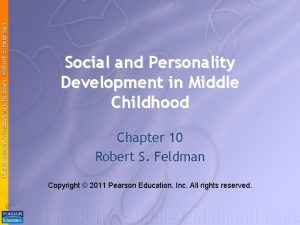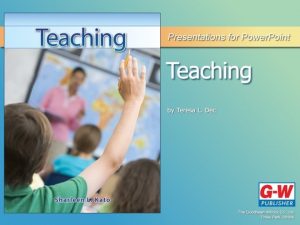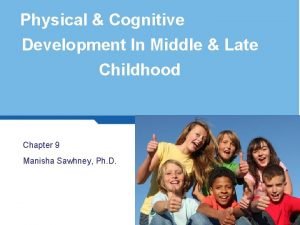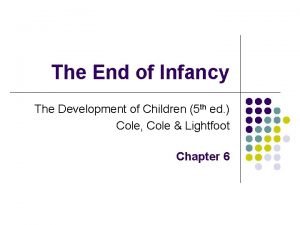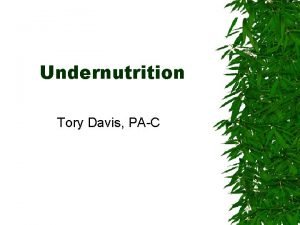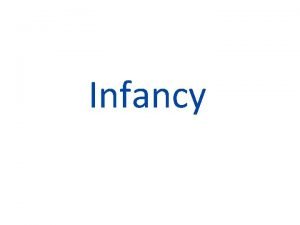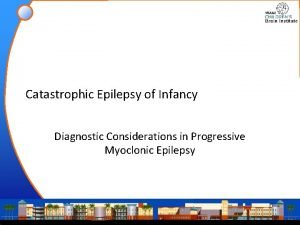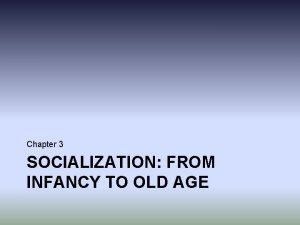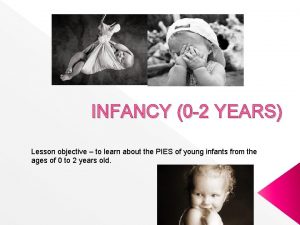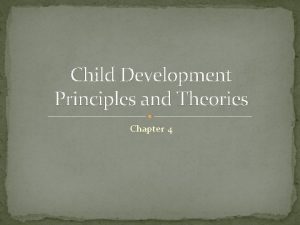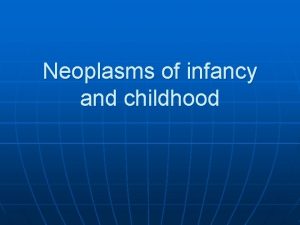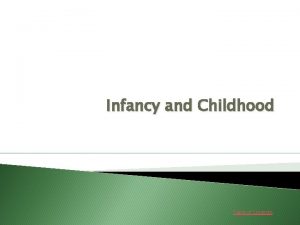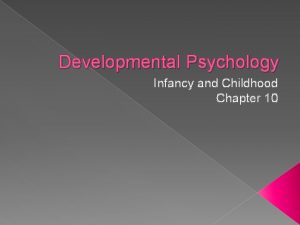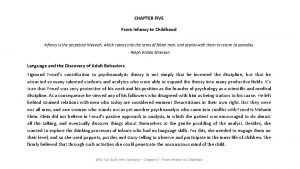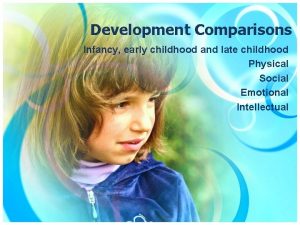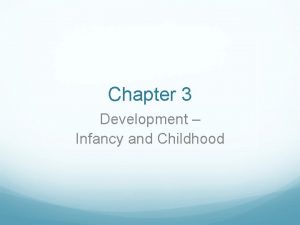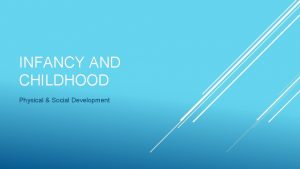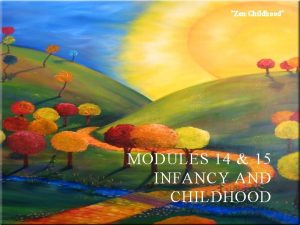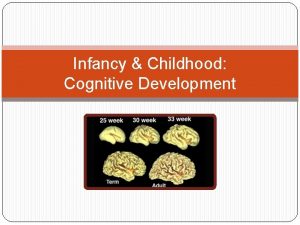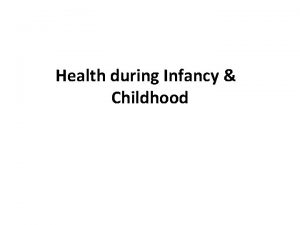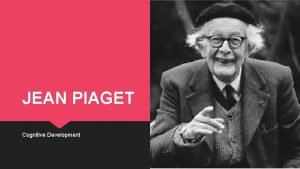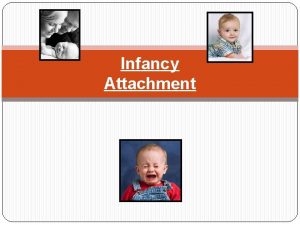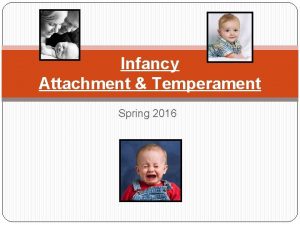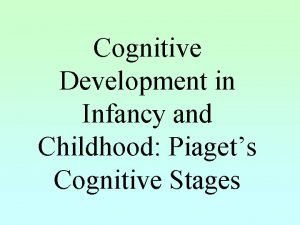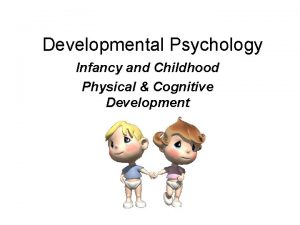Child Development Infancy and Childhood Infancy and Childhood






































- Slides: 38

Child Development - Infancy and Childhood

Infancy and Childhood Infancy: newborns growing almost into toddlers Childhood: toddlers growing almost into teenagers For each of these stages, we will study: § brain development. § motor development. § cognitive development. § social and emotional development.

Maturation: not the meaning you might think § In psychology, “maturation” refers to changes that occur primarily because of the passage of time. § In developmental psychology, maturation refers to biologically-driven growth and development enabling orderly (predictably sequential) changes in behavior. § Experience (nurture) can adjust the timing, but maturation (nature) sets the sequence. Maturation in infancy and early childhood affects the brain and motor skills. For example, infant bodies, in sequence, will lift heads, then sit up, then crawl, and then walk. Maturation, the biological unfolding, will be seen in: § brain development. § motor development.

Brain Development: Building and Connecting Neurons § In the womb, the number of neurons grows by about 750, 000 new cells per minute in the middle trimester. § Beginning at birth, the connections among neurons proliferate. As we learn, we form more branches and more neural networks. § In infancy, the growth in neural connections takes place initially in the less complex parts of the brain (the brainstem and limbic system), as well as the motor and sensory strips. This enables body functions and basic survival skills. § In early childhood, neural connections proliferate in the association areas. This enables advancements in controlling attention and behavior (frontal lobes) and also in thinking, memory, and language.

Motor Development § Maturation takes place in the body and cerebellum enabling the sequence below. § Physical training generally cannot change the timing.

Baby Memory Infantile Amnesia § In infancy, the brain forms memories so differently from the episodic memory of adulthood that most people cannot really recall memories from the first three years of life. § A birthday party when turning three might be a person’s first memory. Learning Skills § Infants can learn skills (procedural memories). § This three month old can learn, and recall a month later, that specific foot movements move specific mobiles.

Cognitive Development Cognition refers to the mental activities that help us function, including: § problem-solving. § figuring out how the world works. § developing models and concepts. § storing and retrieving knowledge. § understanding and using language. § using self-talk and inner thoughts.

Cognitive Development: Jean Piaget (1896 -1980) § We don’t start out being able to think like adults. § Jean Piaget studied the errors in cognition made by children in order to understand in what ways they think differently than adults. The error below is an inability to understand scale (relative size).

Piaget

Jean Piaget and Cognitive Development: Schemas § An infant’s mind works hard to make sense of our experiences in the world. § An early tool to organize those experiences is a schema, a mental container we build to hold our experiences. § Schemas can take the form of images, models, and/or concepts. This child has formed a schema called “COW” which he uses to think about animals of a certain shape and size. “Cow!”

Jean Piaget and Cognitive Development:

The Course of Development: Stages Jean Piaget believed that cognitive development: 1. is a combination of nature and nurture. Children grow by maturation as well as by learning through interacting/playing with the environment. 2. is not one continuous progression of change. Children make leaps in cognitive abilities from one stage of development to the next. Issue Nature vs. Nurture Continuity vs. Stages Jean Piaget’s Vote Both Stages

Sensorimotor Stage (From Birth to Age 2) In the sensorimotor stage, children explore by looking, hearing, touching, mouthing, and grasping. Cool cognitive trick learned at 6 to 8 months, coming up next: object permanence.

There’s a game I’ve learned to play all by myself: peekaboo! Object Permanence Through games like “peekaboo, ” kids learn object permanence-the idea that objects exist even when they can’t be seen. Hmm, a bear, should I put it in my mouth?

Can Children Think Abstractly? Jean Piaget felt that kids in the sensorimotor stage did not think abstractly. Yet there is some evidence that kids in this stage can notice violations in physics (such as gravity). Does that mean babies are doing physics?

Is This Math? If so, kids in the “sensorimotor” stage do math. Babies stare longer and with surprise when numbers don’t make sense. Is this math? Was Jean Piaget wrong? 16

What can kids do in the preoperational stage? Preoperational Stage (2 – 6/7 years): 1. Represent their schema, and even some feelings, with words and images. 2. Use visual models to represent other places, and perform pretend play. 3. Picture other points of view, replacing egocentrism with theory of mind. 4. Use intuition, but not logic and abstraction yet.

Egocentrism: “I am the World. ” What mistake is the boy making? Do you have a brother? Does Jim have a brother? How does this relate to our definition of egocentrism? Yes. Jim. No.

Maturing beyond Egocentrism: Developing a “Theory of Mind” Theory of mind refers to the ability to understand that others have their own thoughts and perspective. With a theory of mind, you can picture that Sally will have the wrong idea about where the ball is.

Examples of Operations that Preoperational Children Cannot Do…Yet Conservation refers to the ability to understand that a quantity is conserved (does not change) even when it is arranged in a different shape. Which row has more mice?

Autism Spectrum Disorders § Children with disorders on the autism spectrum have difficulties in three general areas: § establishing mutual social interaction § using language and play symbolically § displaying flexibility with routines, interests, and behavior § Children with disorders on the autism spectrum have more difficulty than a typical child in mentally mirroring the thoughts and actions of others; this difficulty has been called “mind blindness. ”

Happy train How do we teach social/emotional understanding to children with autism? Are the autistic kids learning to understand the emotions of others, or are they memorizing that certain facial positions correspond to certain emotion words?

The Concrete Operational Stage § begins at ages 6 -7 (first grade) to age 11 § children now grasp conservation and other concrete transformations § they also understand simple mathematical transformations the reversibility of operations (reversing 3 + 7 = 10 to figure out that 10 - 7 = 3).

Formal Operational Stage (Age 11 +) Concrete operations include analogies such as “My brain is like a computer. ” Formal operations includes allegorical thinking such as “People who live in glass houses shouldn’t throw stones” (understanding that this is a comment on hypocrisy). Includes arithmetic transformations: if 4 + 8 = 12, 12 – 4 = ? Includes algebra: if x = 3 y and x – 2 y = 4, what is x?

Does Logical Reasoning Begin Earlier? § Kids that Jean Piaget considered too young for logic can correctly answer: If John is in school, then Mary is in school. John is in school. What can you say about Mary? § Is this formal reasoning (in logic terms: “given A B; if A, then also B”), or is it simply following a word pattern? To find out, it might be interesting to test at what age a child would be able to answer these tougher logic questions? If John is in school, then Mary is in school. – John is NOT in school. What can you say about Mary? – Mary is in school. What can you say about John? – Mary is NOT in school. What can you say about John?

Reassessment of Jean Piaget’s Theory Using Models: Symbolic Thinking? Three-year-olds can use a tiny model of a room as a map, helping them to picture the location of objects in a full-sized room. § Does this 3 -year-old ability mean that Piaget was wrong? Do kids use symbolic thought much earlier than he suggested? § http: //www. pbs. org/wnet/huma nspark/episodes/program-twoso-human-so-chimp/video-fullepisode/407/ Although Jean Piaget’s observation and stage theory are useful, today’s researchers believe: 1. development is a continuous process. 2. children show some mental abilities and operations at an earlier age than Piaget thought. 3. formal logic is a smaller part of cognition, even for adults, than Piaget believed.

Lev Vygotsky: Alternative to Jean Piaget § Lev Vygotsky (1896 -1934) studied kids too, but focused on how they learn in the context of social communication. § Principle: children learn thinking skills by internalizing language from others and developing inner speech: “Put the big blocks on the bottom, not the top…” § Vygotsky saw development as building on a scaffold of mentoring, language, and cognitive support from parents and others.

Social Development Stranger Anxiety Stranger anxiety develops around ages 9 to 13 months. In this stage, a child notices and fears new people. Explaining Stranger Anxiety How does this develop? § As children develop schemas for the primary people in their lives, they are more able to notice when strangers do not fit those schemas. However, they do not yet have the ability to assimilate those faces. Why does this develop? § An evolutionary psychologist would note that a child is learning to walk at this age. Some of the children who walked toward unfamiliar creatures might have died before having a chance to pass on genes.

Social Development: Attachment refers to an emotional tie to another person. § In children, attachment can appear as a desire for physical closeness to a caregiver. Origins of Attachment Experiments with monkeys suggest that attachment is based on physical affection and comfortable body contact, and not based on being rewarded with food.

Origins of Attachment: Familiarity § Most creatures tend to attach to caregivers who have become familiar. § Birds have a critical period, hours after hatching, during which they might imprint. This means they become rigidly attached to the first moving object they see.

Attachment Variation: Styles of Dealing with Separation The degree and style of parent-child attachment has been tested by Mary Ainsworth in the “strange situations” test. In this test, a child is observed as: 1. a mother and infant child are alone in an unfamiliar (“strange”) room; the child explores the room as the mother just sits. 2. a stranger enters the room, talks to the mother, and approaches the child; the mother leaves the room. 3. After a few moments, the mother returns. Reactions to Separation and Reunion § Secure attachment: most children (60 percent) feel distress when mother leaves, and seek contact with her when she returns § Insecure attachment (anxious style): clinging to mother, less likely to explore environment, and may get loudly upset with mother’s departure and remain upset when she returns § Insecure attachment (avoidant style): seeming indifferent to mother’s departure and return

What causes these different attachment styles: nature or nurture? Is the “strange situations” behavior mainly a function of the child’s inborn temperament? § Temperament refers to a person’s characteristic style and intensity of emotional reactivity. § Some infants have an “easy” temperament; they are happy, relaxed, and calm, with predictable rhythms of needing to eat and sleep. § Some infants seem to be “difficult”; they are irritable, with unpredictable needs and behavior, and intense reactions. Is the behavior a reaction to the way the parents have interacted with the child previously? If so, is that caused by the parenting behavior? § Mary Ainsworth believed that sensitive, responsive, calm parenting is correlated with the secure attachment style. § Monkeys with unresponsive artificial mothers showed anxious insecure attachment. § Training in sensitive responding for parents of temperamentallydifficult children led to doubled rates of secure attachment.

Attachment Styles… not just about bonding with parents § Erikson’s concept of basic trust resembles the concept of attachment, but extends beyond the family into our feeling of whether the world is predictable and trustworthy. § Attachment style may be relevant to our ability to manage and enjoy adult relationships. It may even be relevant to our motivations to achieve or to avoid risks. ? Erikson believed that basic trust is established by relationships with early caregivers.

Deprivation of Attachment § If children live without safe, nurturing, affectionate caretaking, they may still be resilient, that is bounce back, attach, and succeed. § However, if the child experiences severe, prolonged deprivation or abuse, he or she may: § have difficulty forming attachments. § have increased anxiety and depression. § have lowered intelligence. § show increased aggression.

Children in Day Care § We have seen already that time in day care does not significantly increase or decrease separation anxiety. § Warm interaction with multiple caretakers can result in multiple healthy attachments. § Time in day care correlates with advanced thinking skills… and also with increased aggression and defiance.

Childhood: Self-Concept § A major task of infancy may be to form healthy attachments. § A major task of childhood may be to form a healthy selfconcept: a stable and positive understanding of identity. § By age 8 -10, a child moves from “that’s me in the mirror” to “I have skills, preferences, and goals”; this prepares the child for confident success.

Childhood: Hypothetical Parenting Styles Style Response to Child’s Behavior Authoritarian Parents impose rules “because I said so” “Too Hard” and expect obedience. Permissive Parents submit to kids’ desires, not enforcing “Too Soft” limits or standards for child behavior. Parents enforce rules, limits, and standards Authoritative but also explain, discuss, listen, and express “Just Right” respect for child’s ideas and wishes.

Outcomes with Parenting Styles § Authoritative parenting, more than the other two styles, seems to be associated with: § high self-reliance. § high social competence. § high self-esteem. § low aggression. § But are these a result of parenting style, or are parents responding to a child’s temperament? Or are both a function of culture ? Or genes?
 Middle and late childhood
Middle and late childhood Social development in infancy
Social development in infancy Ap psych schema
Ap psych schema Infancy and childhood physical development
Infancy and childhood physical development Module 46 infancy and childhood physical development
Module 46 infancy and childhood physical development Module 47 infancy and childhood cognitive development
Module 47 infancy and childhood cognitive development Infancy and childhood psychology
Infancy and childhood psychology Psychology chapter 10 infancy and childhood
Psychology chapter 10 infancy and childhood Chapter 10 infancy and childhood review worksheet answers
Chapter 10 infancy and childhood review worksheet answers Psychology chapter 10 infancy and childhood
Psychology chapter 10 infancy and childhood Lesson quiz 3-2 infancy and childhood
Lesson quiz 3-2 infancy and childhood Infancy childhood adolescence adulthood old age
Infancy childhood adolescence adulthood old age Slidetodoc. com
Slidetodoc. com Intellectual meaning health and social care
Intellectual meaning health and social care Chapter 5 cognitive development in infancy and toddlerhood
Chapter 5 cognitive development in infancy and toddlerhood Socioemotional development in infancy
Socioemotional development in infancy Infancy psychosocial development
Infancy psychosocial development The stages of growth
The stages of growth Personality development in infancy
Personality development in infancy Personality development in infants
Personality development in infants New emotions that appear toward the second year
New emotions that appear toward the second year 패자트리
패자트리 Scaffold and fade-away technique
Scaffold and fade-away technique Cognitive development of late childhood
Cognitive development of late childhood Social development in middle childhood
Social development in middle childhood Late childhood emotional development
Late childhood emotional development Social and personality development in middle childhood
Social and personality development in middle childhood Middle childhood growth and development
Middle childhood growth and development Middle and late childhood
Middle and late childhood Infancy period
Infancy period Infancy
Infancy Infancy physical changes
Infancy physical changes Catastrophic epilepsy infancy
Catastrophic epilepsy infancy The cases of anna, isabelle and genie
The cases of anna, isabelle and genie Pies in infancy
Pies in infancy Problems of infancy
Problems of infancy Infancy
Infancy Messianic prophecies fulfilled in the infancy narratives
Messianic prophecies fulfilled in the infancy narratives Chapter 4 child development principles and theories
Chapter 4 child development principles and theories

